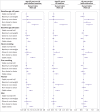Weight change across adulthood in relation to all cause and cause specific mortality: prospective cohort study
- PMID: 31619383
- PMCID: PMC6812615
- DOI: 10.1136/bmj.l5584
Weight change across adulthood in relation to all cause and cause specific mortality: prospective cohort study
Abstract
Objective: To investigate the association between weight changes across adulthood and mortality.
Design: Prospective cohort study.
Setting: US National Health and Nutrition Examination Survey (NHANES) 1988-94 and 1999-2014.
Participants: 36 051 people aged 40 years or over with measured body weight and height at baseline and recalled weight at young adulthood (25 years old) and middle adulthood (10 years before baseline).
Main outcome measures: All cause and cause specific mortality from baseline until 31 December 2015.
Results: During a mean follow-up of 12.3 years, 10 500 deaths occurred. Compared with participants who remained at normal weight, those moving from the non-obese to obese category between young and middle adulthood had a 22% (hazard ratio 1.22, 95% confidence interval 1.11 to 1.33) and 49% (1.49, 1.21 to 1.83) higher risk of all cause mortality and heart disease mortality, respectively. Changing from obese to non-obese body mass index over this period was not significantly associated with mortality risk. An obese to non-obese weight change pattern from middle to late adulthood was associated with increased risk of all cause mortality (1.30, 1.16 to 1.45) and heart disease mortality (1.48, 1.14 to 1.92), whereas moving from the non-obese to obese category over this period was not significantly associated with mortality risk. Maintaining obesity across adulthood was consistently associated with increased risk of all cause mortality; the hazard ratio was 1.72 (1.52 to 1.95) from young to middle adulthood, 1.61 (1.41 to 1.84) from young to late adulthood, and 1.20 (1.09 to 1.32) from middle to late adulthood. Maximum overweight had a very modest or null association with mortality across adulthood. No significant associations were found between various weight change patterns and cancer mortality.
Conclusions: Stable obesity across adulthood, weight gain from young to middle adulthood, and weight loss from middle to late adulthood were associated with increased risks of mortality. The findings imply that maintaining normal weight across adulthood, especially preventing weight gain in early adulthood, is important for preventing premature deaths in later life.
Published by the BMJ Publishing Group Limited. For permission to use (where not already granted under a licence) please go to http://group.bmj.com/group/rights-licensing/permissions.
Conflict of interest statement
Competing interests: All authors have completed the ICMJE uniform disclosure form at http://www.icmje.org/coi_disclosure.pdf (available on request from the corresponding author) and declare: no support from any organisation for the submitted work other than those described above; no financial relationships with any organisations that might have an interest in the submitted work in the previous three years; no other relationships or activities that could appear to have influenced the submitted work.
Figures


References
-
- Abarca-Gómez L, Abdeen ZA, Hamid ZA, et al. NCD Risk Factor Collaboration (NCD-RisC) Worldwide trends in body-mass index, underweight, overweight, and obesity from 1975 to 2016: a pooled analysis of 2416 population-based measurement studies in 128·9 million children, adolescents, and adults. Lancet 2017;390:2627-42. 10.1016/S0140-6736(17)32129-3 - DOI - PMC - PubMed
-
- Karahalios A, English DR, Simpson JA. Change in body size and mortality: a systematic review and meta-analysis. Int J Epidemiol 2017;46:526-46. - PubMed
